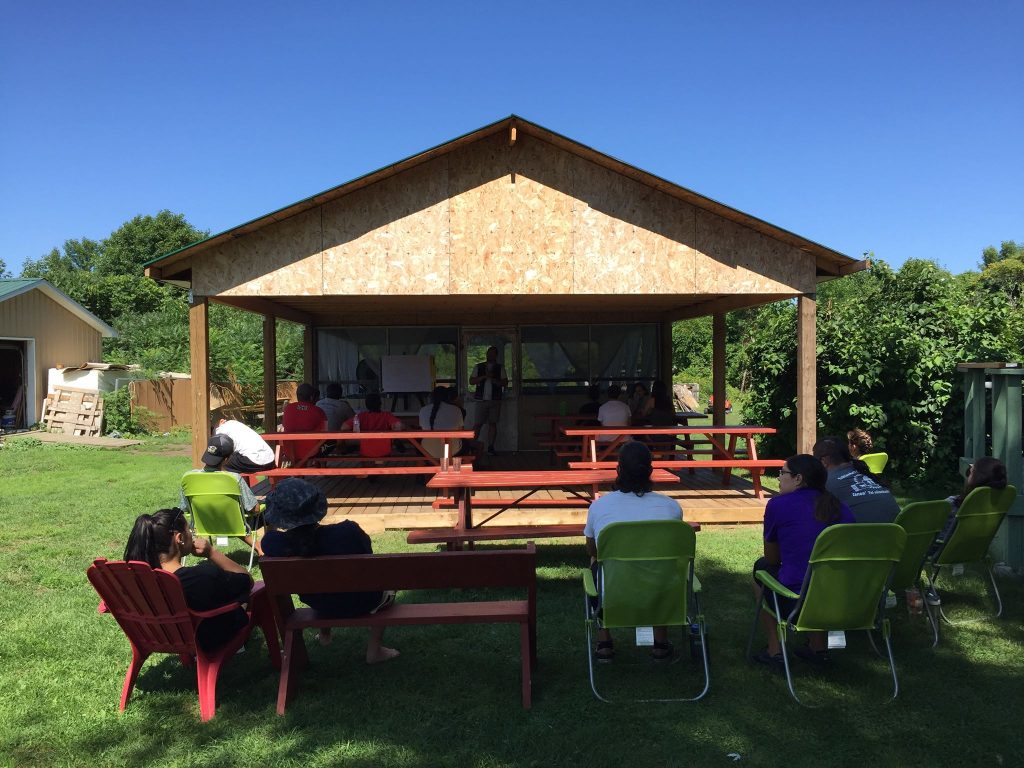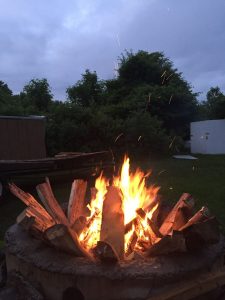By Allen Brett Campeau
I spent most of my Akwesasne internship in Kana:takon in Akwesasne Mohawk territory, but I also had the opportunity to participate in several excursions, both on and off reserve. Two of the most enriching for me were my trips to Ottawa-Carleton Detention Centre (OCDC), a correctional and remand facility in Ottawa, and the Thompson Island Youth Cultural Camp (Tsikionhet Onkwawen:na tanon Tsiniionkwariho:ten), which was held on reserve in the St. Lawrence River. I met with Indigenous inmates at OCDC and Indigenous youth at the Cultural Camp.
At both OCDC and the Cultural Camp, we were joined by Mohawk elders and knowledge-keepers, who shared their knowledge of Mohawk culture and the Mohawk creation story. These teachings emphasized respect for the natural world and humanity’s connection with the land and non-human beings. I was particularly intrigued by the important role of traditional food in medicine and ceremony. Food was prominent in the teachings of the elders and knowledge-keepers at both the OCDC and Thompson Island events. Although the audiences were different, the key message was largely the same: “Whatever life’s hardships, the natural world—Mother Earth—will sustain us.”

I visited OCDC on June 21st for an Indigenous Peoples Day Celebration. Over the course of the day, we met with close to fifty Indigenous inmates—in groups of ten—in the OCDC prison yard, where we shared traditional foods, danced traditional dances, and listened to Mohawk teachings. Many of the inmates had gone months without seeing grass, I learned; they were immensely grateful for the chance to sit outdoors on this sunny day, with grass beneath their feet. Many inmates took off their shoes to make the most of their brief time in the yard. After less than an hour, they would be ushered back indoors. Our moments together were quite short, but they still felt significant. The inmates were all very kind and happy to meet with us.
After listening to the knowledge-keepers and dancing a few dances, we sat around a fire for a traditional meal: corn soup, frybread, and strawberries. I helped to prepare the food the night before, so the opportunity to share it with the inmates, and to learn about its significance from the knowledge-keepers, was very rewarding. The heart-shaped strawberry is symbolic of life and heath. It is recognized as a leader of the medicine plants because of its early ripening in the new year. It was also, I learned, one of two plants (along with tobacco) to have descended to Turtle Island with Skywoman in the Mohawk creation story. It is a food of incredible cultural significance, but likely one that few OCDC inmates had enjoyed since their incarceration. However, as one elder pointed out, strawberry plants could be found growing in the prison yard.

In the relatively lush surroundings of Thompson Island, strawberries and other traditional food and medicine plants were abundant. The rich natural setting made the perfect backdrop for the mid-August Cultural Camp. I acted as a chaperone for some of the twenty-odd Mohawk teenagers that came to learn about their culture, practice traditional skills, and enjoy the outdoors. We swam, canoed, played lacrosse, and ate good food. After burning off some energy, we would also sit and listen to traditional Mohawk teachings, including an hours-long telling of the Mohawk creation story. Here too, like at OCDC, we learned about the central importance of love and respect for Creation.
Many of the young people came to the Cultural Camp because they wanted to be there, but presumably some came at the insistence of their parents or loved ones—“it will be good for you”. It was, after all, an opportunity to learn more about Mohawk language, traditions, and stories. For a young Indigenous person—indeed, any person—knowledge about and pride in your culture and identity is crucial to living a good life. It keeps you grounded in and connected to your community. In Indigenous worldviews, this connection to community easily extends to the natural world. It is maintained through time in nature and participation in traditional practices, including those surrounding traditional foods.
In my last evening at the Cultural Camp, we sat around a fire and danced many of the same dances that we tried at OCDC. It was easy to see parallels between the experiences: we were all connecting or reconnecting to nature and culture, and in so doing, nurturing a part of ourselves that is often underdeveloped in modern urban or reserve life. For the OCDC inmates, the sense of estrangement from nature, culture, and community was likely more acute, but it is something that many of us struggle with, even in ideal circumstances. We can all benefit from time immersed in nature and culture, learning from our elders and peers, whether at camp for a week or just an hour with good food in the sun.
